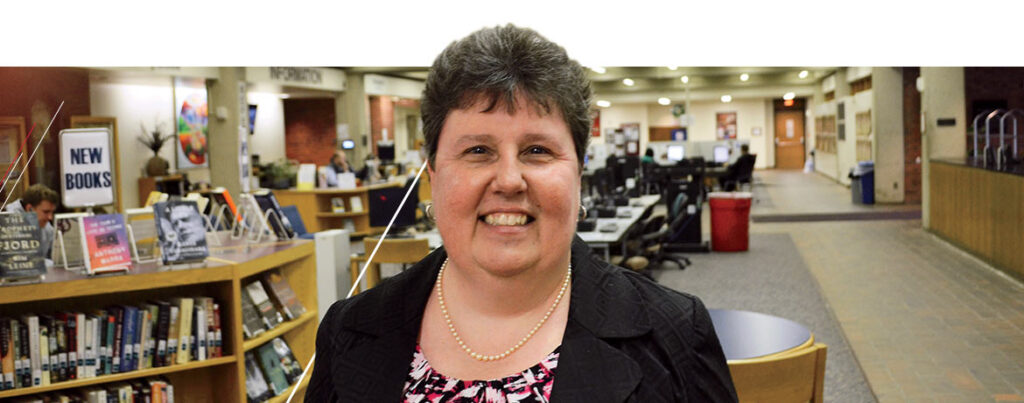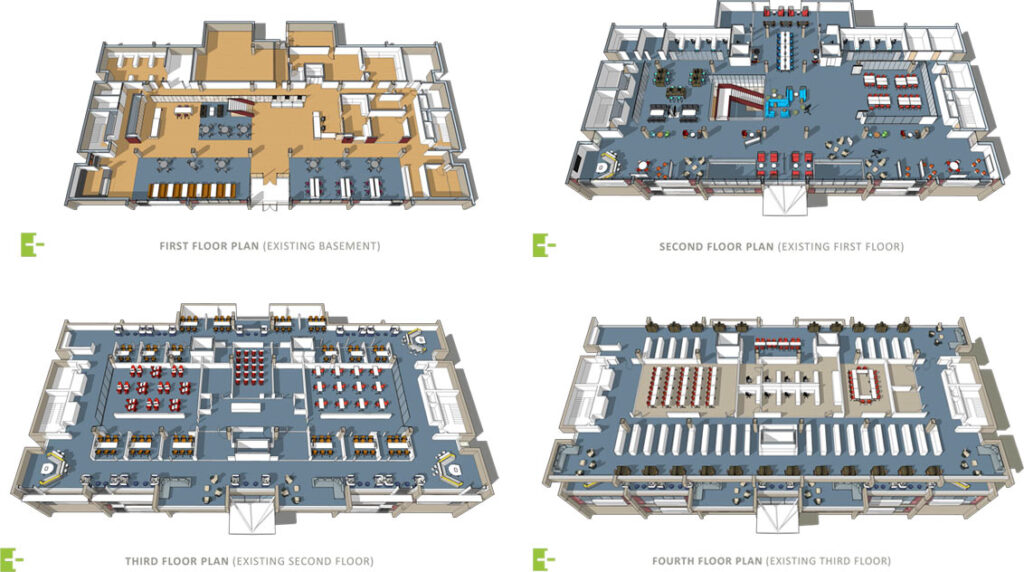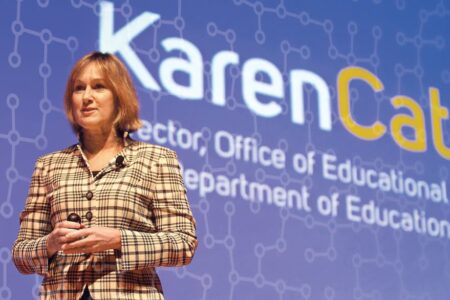Babson Transformation Brings Learning Commons Concept to Campus
Library evolving into 21st century learning commons
Library evolving into 21st century learning commons
In a move that promises to resonate with Springfield College’s tradition of evolving with the needs of its students, the transformation of Babson Library into a 21st century learning commons—complete with technology-friendly infrastructure, numerous repairs and upgrades, and flexible spaces for collaborative learning—will soon begin.
“A learning commons is the heart of a college’s academic program,” explains President Mary-Beth Cooper. “Our Learning Commons will be a beacon, a beautiful and inviting facility that contains all of the resources today’s students require to study, research, work in groups, and receive writing and other academic help,” she explains.
“Our Learning Commons will become, as our academic programming is now, a focal point of this campus for our students and faculty,” says Cooper.
Renovations on the 45-year-old Babson will begin in August with the new space set to open in time for the 2017-18 academic year. When the project is complete, planners say the Learning Commons will be a cornerstone of campus academic life—an inspiring space where Springfield students can study, collaborate, and create. New features will include a 24-hour reading room, a café, a technology hub designed to promote collaboration between research and information technology, and a relocated Academic Success Center positioned to provide support to a more diverse group of students.
The plan is in line with 21st century library innovations at colleges and universities nationwide, where emphasis has shifted from the library as a warehouse of information to a model that supports multiple modes of learning. In a recent article, the American Library Association says a modern learning commons can “serve a unique purpose in the school as a bridge between educational philosophy being practiced and the real world. As such, the learning commons serves school curriculum but also is known as a place for experimenting, playing, making, doing, thinking, collaborating, and growing.”
It is just this kind of synergy that educators at the College see as vital to the new incarnation of Babson Library.
“You have to meet the learning styles of the students,” says Mary Ann Coughlin, G’84, DPE’87, associate vice president for academic affairs. “Many of our Springfield College students are collaborative learners, so having collaborative spaces and technological resources available to them is important.”
Library Director Andrea Taupier G’02 agrees.
“The kind of support that we need to give our students and faculty has changed,” she says. “The new spaces that we’re going to create will have the flexibility to respond to student and faculty needs that we currently don’t have in a building that was built to support an older model of education. At the time this building was built it was a very effective building. But education has changed since the 1970s.”

Those changes—heralded by ebooks, online journals, social media, search-engines, and an age of instantaneous information—are exactly what the renovation will be designed to address.
“I see it as transformative,” Coughlin says, “for our students, for our campus, and for our faculty. Most of the material today’s students need is not on bookshelves. It’s available electronically, and the resources are just that much richer.”
According to Coughlin, the revamped space will provide a welcome nexus of study and academic support, and will give Springfield College students access to spaces that allow them to work more comfortably and productively.
Taupier, who has worked at Springfield since 1986 and has served as director of Babson Library since 2003, says she was delighted when President Cooper made the renovation a priority. In January 2014, when the project was still in its earliest stages, Taupier led a traveling research team on visits to several colleges that had implemented the learning commons model.
“Part of this project is to acknowledge that libraries are no longer what they were in 1972, when the Babson building was built,” Taupier says. “Another is to address some of the deferred maintenance issues. But it’s also a wonderful opportunity to move from the traditional library to a learning commons model, which actually speaks to: ‘What is the role of the library?’ And because we have all of our professional and continuing studies campuses around the country, we’ve been trying to make decisions that will allow access to all of our students, not just those at the Springfield campus.”
Taupier also sees a major efficiency gain. In the current configuration, she says, a student might have to interrupt his or her work to move between buildings several times. But with the renovation, three critical services—library research, technology support, and the Academic Success Center (currently located in Hickory Hall)—will come together. The changes will ameliorate situations where students might come to Babson to write a paper, realize they have to go to the center for help with a citation, then realize they need another article and have to trek back to Babson.
“There’s a range of academic-support solutions that we want to put together here,” Taupier says. “Not only to put them in one building but also to align them so students have more of an ability to get all the different help they need. The learning commons model is the hallmark of that alignment.”
One of the people closest to the project—and most closely involved with the nuts and bolts of day-to-day operations—is Greg Walters, the College’s director of facilities and campus services, who was introduced to the Learning Commons plan right before he was hired in 2015.
“I first heard about it during my interview,” Walters says. “And I had come from a school where we had just completed a library renovation. So we talked about the process and making sure all the constituencies have input.”
Walters started by meeting with Taupier, who was fresh from her learning-commons research visits. Taupier shared a list of libraries she and the team had admired, and the two looked up the designers for each, ultimately sending requests for qualifications to 12 architects. From the responses, three candidates were brought to campus for interviews, and the College selected Boston’s ICON Architecture.
Then, Walters says, “We met with the main groups that are going to be in the new library: the library staff, the IT staff, and the Academic Success Center. We also met with a student organization and the faculty senate.”
With input from all constituencies in hand, a facilities assessment was next, to determine the current condition of the building, including necessary maintenance and updated code compliance.
“Our Learning Commons will be a beacon, a beautiful and inviting facility that contains all of the resources today’s students require to study, research, work in groups, and receive writing and other academic help.”
President Mary-Beth Cooper
Although much of the design is still in progress, Walters says there are already some definite plans. The front stairs will come off the building and a new, fully accessible entrance will invite patrons into the new first floor on what is now the basement level. The library information desk and IT help desk will move down to that floor, making students’ choices and movement through the space more intuitive. Along with the café and reading room, plans are in the works for a new roof, a new heating and air-conditioning system, and revamped lighting, among other upgrades.
Of course, there will also be plenty of space for learning and working in teams.
“There will be a lot of interactive areas, along with furniture and technology to allow customization,” Walters says. “Basically you’ll be able to work in groups, share information, and use moveable white boards or television screens, so you can take whatever’s on your phone or computer or tablet and wirelessly put it up on the screen. Multiple people will be able to do that at the same time.”

As the College vets software to allow such collaboration, designers are thinking hard about the use of space to allow for everything from poetry readings to academic talks to alumni events. One priority is creating a facility that fosters group work—including a “forum” space available for classes, presentations, and other uses—while also ensuring that students seeking quiet can study undisturbed.
Even the quieter spaces, however, won’t look or feel traditional, Walters says, given that students retrieve information very differently than they once did.
[This is] a wonderful opportunity to move from the traditional library to a learning commons model, which actually speaks to: ‘What is the role of the library?’ And because we have all of our professional and continuing studies campuses around the country, we’ve been trying to make decisions that will allow access to all of our students, not just those at the Springfield campus.”
Library Director Andrea Taupier
“Instead of hunched over a desk with a green lamp on it with five books open, a student might have a phone out, a computer out, and maybe one book,” he says. “The space will be more appropriate for how students are studying and learning these days.”
With plans nearing completion, the College estimates the cost of the project to be in the $18-to-$20 million range. The College is actively seeking $8 million in gifts, funding the balance of the renovations through Springfield College reserves and prudent financing.
“We’re talking to some of our closest donors about this project,” says John White, Springfield College vice president for development and alumni relations. “Everyone understands why a college should have a functioning learning commons; they understand the impact of technology on education; and they understand that our students should expect to have a top-of-the-line place to study.”
White says the changes are also expected to have a welcome effect on the College’s already-high retention rate, the percentage of first-year students who return as sophomores.
“We’re finding that by expanding our programs on the academic-support side, we’re able to reach more students, they’re feeling better, and they’re staying,” White says. “So it stands to reason that if we can continue to expand those programs in a central location, it should certainly help our retention.”
“The Learning Commons is an important investment for Springfield College,” concludes Cooper. “When complete, the Learning Commons will enhance educational opportunities for current and future students across all academic disciplines, from our thought-provoking humanities offerings to our focused health science courses.”
Abe Loomis is a freelance writer living in western Massachusetts.



